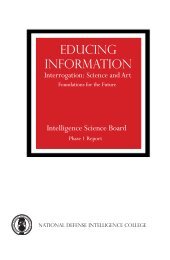Critical Thinking and Intelligence Analysis
Critical Thinking and Intelligence Analysis
Critical Thinking and Intelligence Analysis
Create successful ePaper yourself
Turn your PDF publications into a flip-book with our unique Google optimized e-Paper software.
thinking about the crisis might have raised are included in table 2.<br />
Applying Paul <strong>and</strong> Elder’s model reveals other considerations that<br />
conceivably would have led to an earlier detection of the likelihood<br />
of the deployed weapons being offensive.<br />
Would this approach have allowed detection of what the Soviets<br />
were doing in Cuba before mid-October 1962 One could argue<br />
counterfactually that it might have enhanced analysis of collection<br />
from other sources. 60 SIGINT assets capable of collecting Russian<br />
communications were in place near the isl<strong>and</strong>. 61<br />
Imagery assets might<br />
have been tasked differently prior to 14 October. Sources less subject<br />
to generating noise would have introduced inconsistencies to an<br />
analysis of competing hypotheses that was solely HUMINT-based.<br />
Between Dogmatism <strong>and</strong> Refutation<br />
A systematic approach to directed collection also would have<br />
moved analysts toward a disconfirmatory analytic approach.<br />
By contrast, a confirmatory approach, often characterized as<br />
confirmation bias, leads analysts to accept what they set out to<br />
confirm. 62<br />
A disconfirmatory approach aims to refute alternative<br />
60 Counterfactual reasoning explores differing outcomes arising from<br />
alternative causes. Counterfactuals are commonly used in whenever alternate<br />
hypotheses are explored. They are essential for both post-mortem reviews <strong>and</strong><br />
futures scenario exercises. See Philip E. Tetlock, <strong>and</strong> Aaron Belkin, Counterfactual<br />
Thought Experiments in World Politics: Logical, Methodological, <strong>and</strong> Psychological Perspectives<br />
(Princeton, NJ: Princeton University Press, 1996), 1–38. In the same volume,<br />
Richard Ned Lebow <strong>and</strong> Janice Gross Stein conduct a counterfactual review<br />
of the Cuban missile crisis. See Richard Ned Lebow, <strong>and</strong> Janice Gross Stein,<br />
“Back to the Past: Counterfactuals <strong>and</strong> the Cuban Missile Crisis,” in Philip E.<br />
Tetlock, <strong>and</strong> Aaron Belkin, Counterfactual Thought Experiments in World Politics: Logical,<br />
Methodological, <strong>and</strong> Psychological Perspectives (Princeton, NJ: Princeton University<br />
Press, 1996), 119–148.<br />
61 Johnson <strong>and</strong> Hatch, NSA. According to the authors, SIGINT played a key<br />
role in determining the operational status of the SA-2 air defense missiles. However,<br />
SIGINT failed to detect the delivery <strong>and</strong> installation of the nuclear missiles.<br />
62 Wikipedia defines confirmation bias as “a type of cognitive bias toward<br />
confirmation of the hypothesis under study.” (Wikipedia, entry under “confirmation<br />
bias”).<br />
– 26 –
















